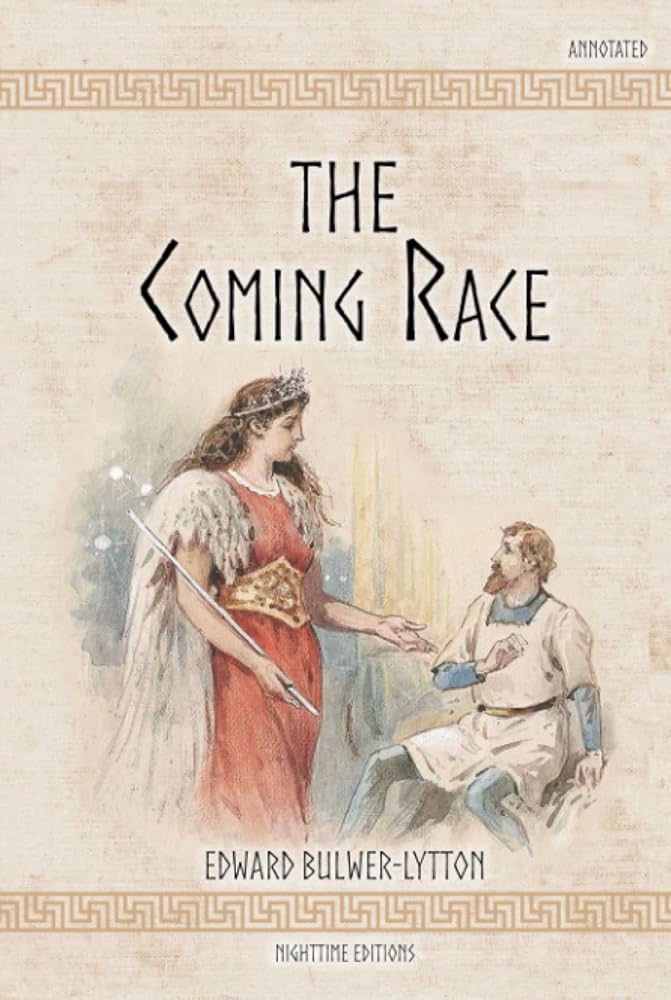Chapter XV — The coming Race
byChapter XV begins with a simple suggestion from Zee that carries a deeper intention—she encourages me to adopt the clothing of the Vril-ya. Without their signature wings, I would pass among them as a traveler of lesser rank, avoiding unnecessary attention. Donning their attire was both an invitation and an initiation—a way to observe their society more intimately without causing disruption. The garments, though elegant in design, were surprisingly comfortable and tailored for both grace and ease. My appearance now blended with theirs, yet internally I remained marked by difference. As I moved through their city, I noticed a layout both functional and beautiful—large, well-structured, and rich in cultivated lands that seamlessly fed the population. It was not built to impress with grandeur, but to sustain and elevate life in all its forms.
What struck me most was their treatment of animals. There were no creatures kept for labor or status—no barking dogs guarding gates or horses pulling carriages. Instead, birds flitted freely, admired for their song, not caged for amusement. The Vril-ya’s bond with life did not stem from dominance but mutual respect. Their machines, powered by vril, made beasts of burden obsolete. Air-boats drifted across the sky without smoke or sound, and land transports glided smoothly over roadways with quiet precision. Their economy relied on neutral zones of cultivated land shared peacefully between settlements, facilitating trade and interaction without tension. Nothing was fortified. Nothing guarded. Trust, not fear, held their communities together.
Zee described their agricultural techniques, which required less effort but yielded more nutrition than anything I had seen above ground. Even in their gardens, artistry met practicality. The food tasted clean and rich, with no excess or waste. Their focus on balance extended to their bodies as well. Every citizen appeared strong, healthy, and symmetrical. Age did not erode beauty. Wrinkles and frailty seemed nearly absent. Physical decay had been slowed not through vanity, but through care and science. Their homes reflected the same harmony: bright, open, filled with air and light. Each room felt like an extension of the mind—clear, undisturbed, and uncluttered.
Their education model fascinated me. Children were not crammed with facts or tested through competition. Instead, instruction focused on internal development—morality, reasoning, and empathy formed the core of their learning. From an early age, they were taught not only how to think, but how to live. With this foundation, disputes became rare, and punishment unnecessary. Teachers guided rather than commanded. Discipline came not from fear but from understanding. In such a system, learning felt like growth rather than survival. They did not aspire to conquer others, only themselves.
Later that evening, we discussed the physical evolution of the Vril-ya. Their skulls were slightly larger, foreheads higher, and facial features more refined. Compared to the rugged contours of humanity, their faces carried serenity without softness. Aph-Lin traced this to their peaceful history and deliberate social shaping. Conflict had not shaped their bone structure; contemplation had. Their culture rewarded calmness, and their features slowly reflected that value over generations. Zee remarked that moral character and physical form had long been intertwined. The more stable a society, the more its people began to look the part. Beauty here was not ornamental. It was an echo of harmony.
As our conversation deepened, I couldn’t help but defend the energy and passion that define human civilization. Zee listened but did not agree. She argued that ambition without purpose leads to decay, and that conflict, though once necessary for growth, should not be mistaken for progress. The Vril-ya had moved past it. Their society did not fear difference, but had learned to live above division. They no longer competed—they contributed. Individual achievement mattered, but not at the expense of others.
To them, real advancement came not from invention or wealth, but from peace of mind. Their concept of utopia was not mythical—it was engineered. They did not dream of heaven; they built it, slowly and patiently. Zee’s closing words lingered with me: true civilization was not the conquest of nature or others, but of self. And in mastering themselves, the Vril-ya had found what most humans still chase without end—order without oppression, freedom without chaos, and knowledge without arrogance. For the first time, I saw a vision of society that was not just different, but perhaps wiser.


